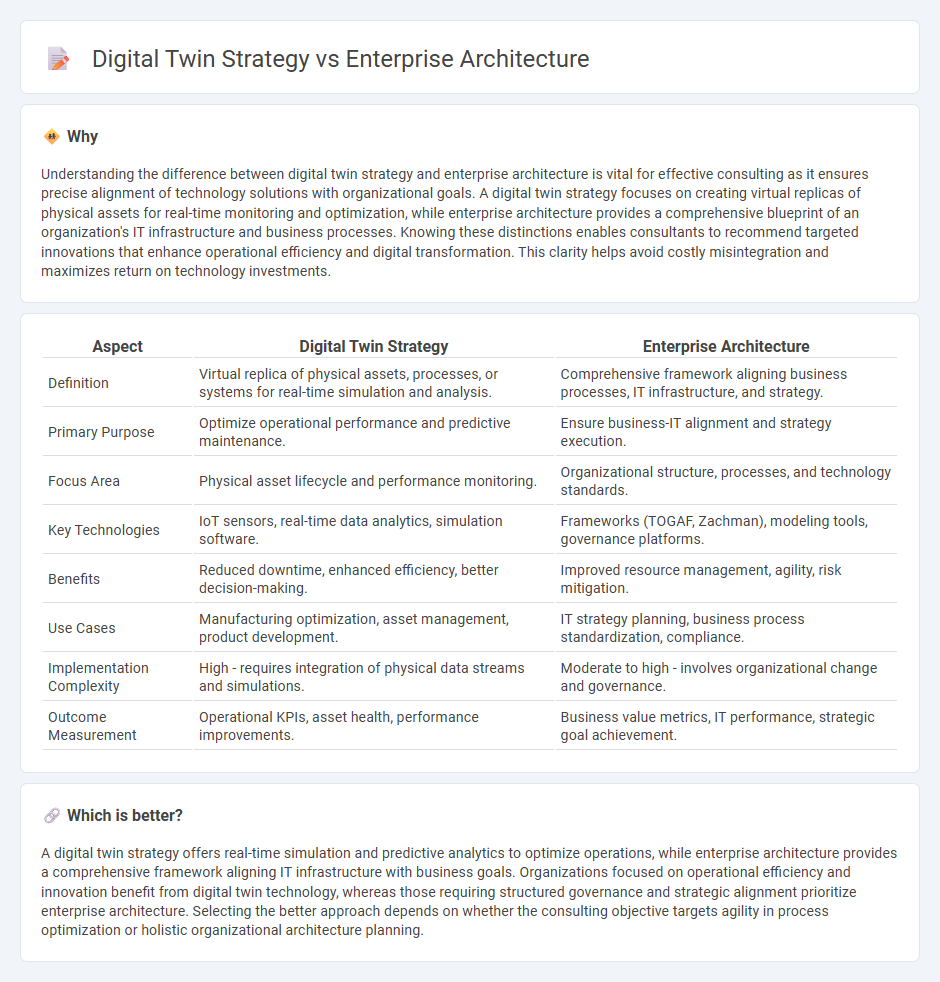
Digital twin strategy leverages real-time data to create virtual replicas of physical assets, optimizing operational efficiency and predictive maintenance. Enterprise architecture provides a comprehensive framework aligning IT infrastructure and business processes to support organizational goals and scalability. Explore how integrating digital twin technology with enterprise architecture can drive innovation and strategic transformation.
Why it is important
Understanding the difference between digital twin strategy and enterprise architecture is vital for effective consulting as it ensures precise alignment of technology solutions with organizational goals. A digital twin strategy focuses on creating virtual replicas of physical assets for real-time monitoring and optimization, while enterprise architecture provides a comprehensive blueprint of an organization's IT infrastructure and business processes. Knowing these distinctions enables consultants to recommend targeted innovations that enhance operational efficiency and digital transformation. This clarity helps avoid costly misintegration and maximizes return on technology investments.
Comparison Table
| Aspect | Digital Twin Strategy | Enterprise Architecture |
|---|---|---|
| Definition | Virtual replica of physical assets, processes, or systems for real-time simulation and analysis. | Comprehensive framework aligning business processes, IT infrastructure, and strategy. |
| Primary Purpose | Optimize operational performance and predictive maintenance. | Ensure business-IT alignment and strategy execution. |
| Focus Area | Physical asset lifecycle and performance monitoring. | Organizational structure, processes, and technology standards. |
| Key Technologies | IoT sensors, real-time data analytics, simulation software. | Frameworks (TOGAF, Zachman), modeling tools, governance platforms. |
| Benefits | Reduced downtime, enhanced efficiency, better decision-making. | Improved resource management, agility, risk mitigation. |
| Use Cases | Manufacturing optimization, asset management, product development. | IT strategy planning, business process standardization, compliance. |
| Implementation Complexity | High - requires integration of physical data streams and simulations. | Moderate to high - involves organizational change and governance. |
| Outcome Measurement | Operational KPIs, asset health, performance improvements. | Business value metrics, IT performance, strategic goal achievement. |
Which is better?
A digital twin strategy offers real-time simulation and predictive analytics to optimize operations, while enterprise architecture provides a comprehensive framework aligning IT infrastructure with business goals. Organizations focused on operational efficiency and innovation benefit from digital twin technology, whereas those requiring structured governance and strategic alignment prioritize enterprise architecture. Selecting the better approach depends on whether the consulting objective targets agility in process optimization or holistic organizational architecture planning.
Connection
Digital twin strategy leverages enterprise architecture to create dynamic, virtual models of physical assets, enabling real-time data integration and process optimization. Enterprise architecture provides the structural framework that supports the digital twin's alignment with business goals, technology standards, and operational workflows. This synergy enhances decision-making, reduces risks, and drives innovation within consulting engagements focused on digital transformation.
Key Terms
Business Capability Mapping
Enterprise architecture focuses on aligning business processes and IT infrastructure through comprehensive Business Capability Mapping to optimize organizational efficiency and strategic goals. Digital twin strategy leverages real-time data modeling to simulate and analyze business operations, enabling proactive decision-making and performance improvement. Explore how integrating Business Capability Mapping with digital twin technology can transform enterprise strategy and operational excellence.
Data Integration
Enterprise architecture emphasizes aligning IT infrastructure with business goals to ensure seamless data integration across systems, enabling efficient information flow and process optimization. Digital twin strategy focuses on creating real-time, dynamic data models that integrate sensor data and operational insights for enhanced simulation, monitoring, and decision-making. Explore how these approaches complement each other to drive advanced data integration and business intelligence.
Real-time Simulation
Enterprise architecture provides a structured framework for aligning business processes, IT infrastructure, and technology investments to achieve organizational goals efficiently. Digital twin strategy emphasizes real-time simulation by creating dynamic, virtual replicas of physical assets or systems to optimize performance, predict failures, and drive innovation. Explore how integrating enterprise architecture with digital twin strategy enhances decision-making and operational agility.
Source and External Links
What is enterprise architecture? Definition | MEGA - Define enterprise architecture as a framework that aligns business strategy, processes, and technology, enabling organizations to analyze, design, and implement comprehensive, evolving structures across four primary layers: business, application, information, and technology.
Classic Topics - Enterprise Architecture | MIT CISR - Describes enterprise architecture as the organizing logic for business process and IT capabilities, reflecting the firm's operating model and serving as a strategic tool to align IT and business strategy for greater business value.
Enterprise architecture - Wikipedia - Presents enterprise architecture as a business function focused on analyzing and designing the structures and behaviors of organizations, particularly how roles, processes, and data interact to execute strategic objectives.
 dowidth.com
dowidth.com